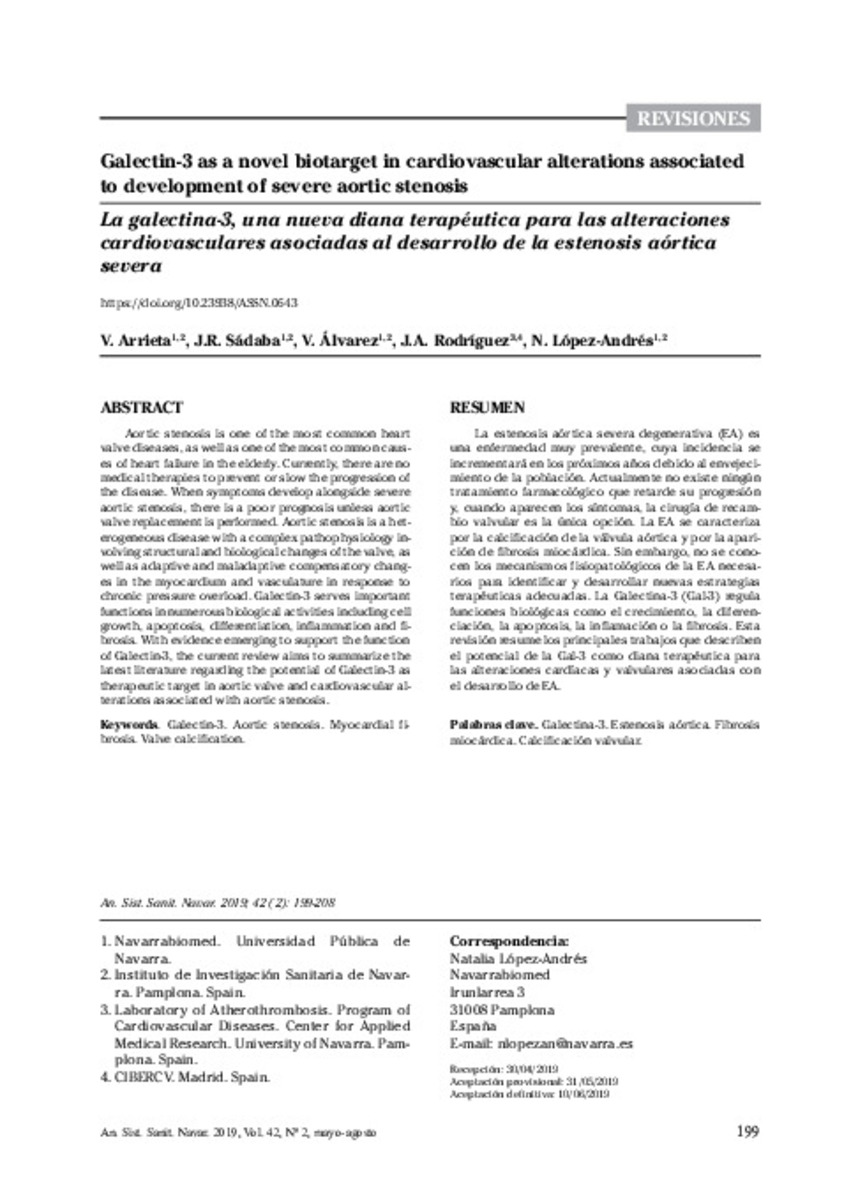Full metadata record
| DC Field | Value | Language |
|---|---|---|
| dc.creator | Arrieta, V. (V.) | - |
| dc.creator | Sádaba, J.R. (J. Rafael) | - |
| dc.creator | Álvarez, V. (V.) | - |
| dc.creator | Rodriguez, J.A. (José Antonio) | - |
| dc.creator | Lopez-Andres, N. (Natalia) | - |
| dc.date.accessioned | 2023-01-11T13:40:18Z | - |
| dc.date.available | 2023-01-11T13:40:18Z | - |
| dc.date.issued | 2019 | - |
| dc.identifier.citation | Arrieta, V. (V.); Sádaba, J.R. (J. Rafael); Álvarez, V. (V.); et al. "La galectina-3, una nueva diana terapéutica para las alteraciones cardiovasculares asociadas al desarrollo de la estenosis aórtica severa". Anales del Sistema Sanitario de Navarra. 42 (2), 2019, 199 - 208 | es |
| dc.identifier.issn | 1137-6793 | - |
| dc.identifier.uri | https://hdl.handle.net/10171/64975 | - |
| dc.description.abstract | Aortic stenosis is one of the most common heart valve diseases, as well as one of the most common causes of heart failure in the elderly. Currently, there are no medical therapies to prevent or slow the progression of the disease. When symptoms develop alongside severe aortic stenosis, there is a poor prognosis unless aortic valve replacement is performed. Aortic stenosis is a heterogeneous disease with a complex pathophysiology involving structural and biological changes of the valve, as well as adaptive and maladaptive compensatory changes in the myocardium and vasculature in response to chronic pressure overload. Galectin-3 serves important functions in numerous biological activities including cell growth, apoptosis, differentiation, inflammation and fibrosis. With evidence emerging to support the function of Galectin-3, the current review aims to summarize the latest literature regarding the potential of Galectin-3 as therapeutic target in aortic valve and cardiovascular alterations associated with aortic stenosis. | es_ES |
| dc.description.abstract | La estenosis aórtica severa degenerativa (EA) es una enfermedad muy prevalente, cuya incidencia se incrementará en los próximos años debido al envejecimiento de la población. Actualmente no existe ningún tratamiento farmacológico que retarde su progresión y, cuando aparecen los síntomas, la cirugía de recambio valvular es la única opción. La EA se caracteriza por la calcificación de la válvula aórtica y por la aparición de fibrosis miocárdica. Sin embargo, no se conocen los mecanismos fisiopatológicos de la EA necesarios para identificar y desarrollar nuevas estrategias terapéuticas adecuadas. La Galectina-3 (Gal-3) regula funciones biológicas como el crecimiento, la diferenciación, la apoptosis, la inflamación o la fibrosis. Esta revisión resume los principales trabajos que describen el potencial de la Gal-3 como diana terapéutica para las alteraciones cardíacas y valvulares asociadas con el desarrollo de EA. | es_ES |
| dc.language.iso | spa | es_ES |
| dc.rights | info:eu-repo/semantics/openAccess | es_ES |
| dc.subject | Galectin-3 | es_ES |
| dc.subject | Aortic stenosis | es_ES |
| dc.subject | Myocardial fibrosis | es_ES |
| dc.subject | Valve calcification | es_ES |
| dc.subject | Galectina-3 | es_ES |
| dc.subject | Estenosis aórtica | es_ES |
| dc.subject | Fibrosis miocárdica | es_ES |
| dc.subject | Calcificación valvular | es_ES |
| dc.title | La galectina-3, una nueva diana terapéutica para las alteraciones cardiovasculares asociadas al desarrollo de la estenosis aórtica severa | es_ES |
| dc.title.alternative | Galectin-3 as a novel biotarget in cardiovascular alterations associated to development of severe aortic stenosis | es_ES |
| dc.type | info:eu-repo/semantics/article | es_ES |
| dc.publisher.place | Navarra | es_ES |
| dc.identifier.doi | 10.23938/ASSN.0643 | - |
| dadun.citation.endingPage | 208 | es_ES |
| dadun.citation.number | 2 | es_ES |
| dadun.citation.publicationName | Anales del Sistema Sanitario de Navarra | es_ES |
| dadun.citation.startingPage | 199 | es_ES |
| dadun.citation.volume | 42 | es_ES |
| dc.identifier.pmid | 31317953 | - |
Files in This Item:
Statistics and impact
Items in Dadun are protected by copyright, with all rights reserved, unless otherwise indicated.






